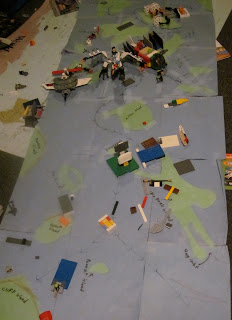A couple of weeks ago Papa took the boys backpacking in Yosemite for the week. We pointed out to them that this was their school assignment for the week. They left on Monday and came home on Friday.
 |
| The trip plan from Tenaya Lake to Happy Isles (red), with side trip to Half Dome (blue) |
After spending the night in Yosemite Valley on Monday night, they were up early on Tuesday catch the shuttle bus that would take them to the trail head. From Tuesday through Friday they hiked almost 22 miles with a total elevation gain of about 13,000 feet. They summited both Cloud's Rest and Half Dome along the way.
 |
| The first day on the trail |
They came home full of excitement. They'd had a great time!
 |
| Back at the car, before getting a shower |
I was pretty disappointed to hear, that in the rush to get to the shuttle bus on time, the camera had been left behind in the car. I was really feeling jealous of their adventures (while I stayed home with Little Miss, age 2) and was eager to relive their trek with them through the pictures they had taken. As luck would have it, they met a nice couple on the same route who took some photos of them along the way and e-mailed them to us!
 |
| A view from Cloud's Rest towards Half Dome and Yosemite Valley |
A couple of days after the trip Curly announced, "That was the best week of school, EVER!"
"Great!", I responded. "What did you learn?"
"Nothing."
I just laughed. I wasn't about to argue with him, and ruin his perfect week of school. I know how much time Papa has spent with them, teaching them to read
topographic maps, using a map and compass, learning how to read a trail map, how to start a fire (about 10 different ways), how to pack for a trip, how to write out and leave an outing plan, how to calculate the right weight of your backpack based on your own body weight, and just about everything else there is to know about backpacking, hiking, rock climbing, and camping.
 |
| About to get on the cables on Half Dome |
The boys told me all about a movie they saw their first night, camping in Yosemite Valley and things they had learned (oops!) about the history of the park. They know, and I'm sure learned more, about the local rocks, fora and fauna than most people. They told me that they saw one marmot. They did not see any pika, but apparently there were some pretty cool pika finger puppets in a the camp store.
 |
| Heading up the cables (not learning anything) |
 |
| At the top of Half Dome with Clouds Rest behind them |
I'm feeling pretty good about the nothing they learned that week with their dad!


















